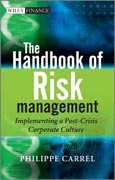
The handbook of risk management: implementing a post crisis corporate culture
Carrel, Philippe
What the world is painfully discovering is that financial risks were never truly managed. Risk management is undergoing a revolution in the aftermath of Basel 2 failure on all 3 pillars - to provide sufficient capital allocations, tocreate sound risk management frameworks and to enhance transparency through disclosure policies. To truly control financial and operational risks, we need to re-purpose risk management from reporting exposure and computing regulatorycapital to enabling corporate strategies and ensuring that they are robust inall business conditions. Repurposing risk management goes well beyond improving ratios, models or regulatory requirements. It is the design and implementation of a corporate culture which involves every single business unit and individuals at each level of the hierarchy. It involves mapping responsibilities and accountabilities according to the distribution of risks. It requires translating risk policies into business targets and reporting back the actual risk appetite observed on the field to the shareholders. It relies on communications with the outside world to better assess the external, systematic factors and adapt risk strategies accordingly. It leads to synergies with the regulators. This handbook gives a practical methodology for a firm to analyse its risk appetite, translate it into risk policies and risk targets and distribute responsibilities and capabilities accordingly. The book will also propose multiple channel information workflows for critical risk data to be conveyed from operational units to decision makers and allow for timely action to be taken. It is based on research on existing and new methodologies, supported with interviews of executives from banks, asset management companies, private wealth managers, hedge funds, administrators, regulators and corporate globally on what has andwhat hasn't worked. Distributing risks exposure and sensitivity across the enterprise Aggregating risk exposure by risk factors Identifying root-risk factors Structural versus cyclical factors Net collateralised value valuations Exposure measurement and reliability assessment Scenarios Dynamic scenario definition Idiosyncratic and market based scenarios Baseline, High Severity, Catastrophic scenarios Assessment of scenario impact on business and risk units Roles and responsibilities Valuation risks Data risk Model risk Liquidity and volatility issues Valuation processes Valuations under scenarios From risk exposure to risk appetite Reporting risk exposure under scenarios Feedback model Aggregated macro-scenarios Empowering business and risk units with risk management capabilities Allocating risk management capabilities Business managers are riskmanagers The role of Executive Risk Committees The role of Audit and Control units The role of executive and non-executive managers Mitigation strategies and hedging tactics Front-line business units Operational units Management RiskCommittees and audit controls Risk weighted performance Principles of risk weighted measurements Quantitative versus qualitative assessments Risk independence or indifference to risk? Operational risks Responsibility and accountability Control and report hierarchy Feedback and information Risk-based information flow Key risk factors and dynamic dashboard Dynamic environment reporting and alert schemes Creating an information workflow for continuous feedback and preventive decision-making From risk appetite to risk policies Risk: The new bond Dynamic two-way information workflow Preventive rules for pre-emptive course of action From risk policies to risk targets Roles of CEO, CFO and ExecutiveRisk Committees The dynamic assessments of risk factor sensitivities Buildingmacro-scenarios Deriving quantitative risk targets Bottom-up feedback Cross-asset sensitivity aggregation Cross-division aggregation pitfalls Cross-market effects and correlations Of correlation and liquidity Reporting under stress, the human factor Model and valuation risks Technological risks Top-Down decisions and feedback Risk dashboards Pre-emptive decision framework Inter-active workflow Audit controls, decision hierarchy rules Deriving a firms Actual Observed Risk Appetite Aggregating worst-case scenarios Building macro-scenarios Risk policies reconciliations Aligning funding strategies and liquidity management tactics with the corporate risk policies Enabling the corporate strategies Asset funding strategies Reconciling strategies and risk policies Liquidity risk management Liquidity buffers and alternative funding conduits Idiosyncraticand market-based scenarios Benchmarking risk and liquidity concentrations Portfolio liquidity risk management Market distribution rules and theories Cyclesand liquidity distribution Anticipating liquidity shifts Mitigating liquidityrisks Reports of funding strategy and liquidity management tactics Aggregating data and scenarios Forward looking presentations External communications, disclosure policies and transparency External communications providing transparent disclosure of exposure, concentrations, macro-scenarios and performance Risk management the new media Disclosure policies Risk management structures Exposure concentrations and portfolio effects Term structure of asset and liability risks Macro-scenarios Actual observed risk appetite Communication models forshareholders and funding partners Risk communications for clients Links and partnerships with regulators Public relations and disclosure policiesPhilippe Carrel (Geneva, Switzerland) is Executive Vice President, Global Head of Business Development in Risk Management, at Thomson Reuters. Specialist of derivatives valuations and regulatory compliance, he was previously Head of Alternative Investments Strategies at Reuters in New York and Director of Riskand Trade Management at Reuters head office in London. Until joining Reuters in 1997, Philippe specialised in advisory services for leading banks and securities companies on derivatives risk measurement, hedging and trading strategies, which followed a career dealing securities and derivatives in Europe and Asia. Philippe also advised regulatory authorities, professional associations and exchanges in emerging markets across Asia. Author of countless articles and white papers, he regularly lectures at high profile seminars and conventions around the world on risk management, hedge fund strategies, and regulatory compliance. Philippe also participates in the financial derivatives programs of leading universities, training and research institutes. His blogs and papers on the changing faces of risk management are available at www.valuationrisk.net. He holds a diploma from the French Grandes Ecoles network.
- ISBN: 978-0-470-68175-6
- Editorial: John Wiley & Sons
- Encuadernacion: Cartoné
- Páginas: 288
- Fecha Publicación: 26/03/2010
- Nº Volúmenes: 1
- Idioma: Inglés
